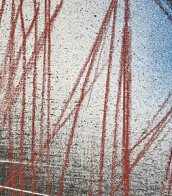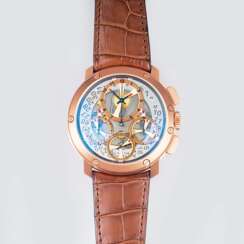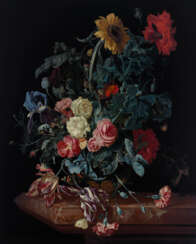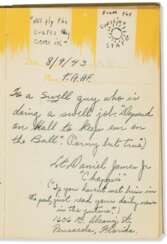guy ellia

Willem van Aelst was a Dutch Golden Age artist renowned for his exquisite still-life paintings featuring flowers, game, and various objects that exemplify the era's opulent lifestyles. Born into a family of city magistrates in Delft, Willem van Aelst trained under his uncle, Evert van Aelst, and became a master in the Guild of Saint Luke at Delft. His career spanned various European cities, including a significant period in Florence as court painter to Ferdinando II de' Medici, Grand Duke of Tuscany, where he was awarded a gold chain and medal for his artistic prowess. The artist signed his paintings with the nickname "Vogelverschrikker" (bird scarecrow), which later became his pseudonym.
Willem van Aelst's contributions to still-life painting were significant, with his works being characterized by intricate attention to detail, use of light and texture, and a mastery in depicting the surfaces of various materials, from the softness of petals to the sheen of metal objects. His paintings often feature elegantly arranged compositions of fruits, flowers, and hunting trophies, set against dark backgrounds that enhance their vivid detail and realism.
His works can be found in prestigious collections worldwide, including the Palazzo Pitti in Florence, the Koninklijk Museum voor Schone Kunsten in Antwerp, the Mauritshuis in The Hague, and the Museo Thyssen-Bornemisza in Madrid. These paintings not only showcase Willem van Aelst's technical skill but also reflect the cultural and aesthetic values of his time, making them invaluable to both historians and art collectors.
Van Aelst's legacy includes teaching notable artists like Rachel Ruysch and Maria van Oosterwijck, highlighting his influence on subsequent generations of still-life painters. Despite his death in 1683, his artistry continues to be celebrated for its elegance and refinement, capturing the essence of the Dutch Golden Age for modern audiences to appreciate.
For collectors and experts in art and antiques, Willem van Aelst's work represents a pinnacle of still-life painting, offering a window into the richness of 17th-century Dutch culture and aesthetics. His pieces are a testament to the enduring beauty and complexity of still-life compositions, making them a prized addition to any collection.
To stay informed about new discoveries and opportunities related to Willem van Aelst's works, including sales and auction events, sign up for updates. This subscription will ensure you remain connected to the vibrant world of Dutch Golden Age art, with a focus on van Aelst's contributions and legacy.


William Shakespeare was a British poet and playwright and writer.
William's father, John Shakespeare, was a merchant and official in Stratford. There are reports that he was a sailor for a time before joining a theater company in London. Beginning in the 1590s, Shakespeare began writing plays, and in 1593 he published a poem, Venus and Adonis, which became popular. He dedicated it to the Duke of Southampton, who was a philanthropist and patron of talent, and soon his business was booming.
From 1592 to 1600 Shakespeare wrote his dramas and romantic comedies "Richard III", "The Taming of the Shrew", "Romeo and Juliet", "A Midsummer Night's Dream" and "The Merchant of Venice", as well as the comedies "Much Ado About Nothing", "Twelfth Night" and the tragedy "Julius Caesar". The playwright's business was so successful that he even bought a large house in Stratford. In 1599, Shakespeare became one of the owners, playwright and actor of the new theater "Globe". In 1603 King James took Shakespeare's troupe under his direct patronage. In the mature period, the great playwright turned to tragedies, there were "Hamlet", "Othello", "King Lear", "Macbeth" and others.
Although in the 19th century researchers had some doubts about the authorship of many of these works, William Shakespeare is considered the greatest English playwright, one of the best playwrights in the world. His plays have been translated into all major languages and to this day form the basis of the world theatrical repertoire, most of them have been screened many times. According to the Guinness Book of Records, Shakespeare remains the world's best-selling playwright, and his plays and poems have sold more than 4 billion copies in the nearly 400 years since his death.


Yves Klein was a French artist, renowned for his innovative use of pure color and his approach to the conceptual aspects of monochrome painting. Klein, born in 1928 in Nice, France, left an indelible mark on the art world despite his brief career, which ended with his untimely death in 1962.
Klein is best known for his invention of International Klein Blue (IKB), a deep blue hue which he registered as a trademark color and used extensively in his works. This vibrant blue, which he developed in collaboration with a chemist, represented more than just a color; it was a means of evoking the immateriality and boundlessness of space. His monochrome blue canvases, large-scale public performances, and pioneering works in performance art established him as a leading figure in the Nouveau Réalisme movement in post-war Europe.
Aside from his famous blue monochromes, Klein’s Anthropometries series, where he used nude women as 'living brushes' to transfer blue paint onto canvases, is another testament to his innovative artistic methods. These performances, often accompanied by a small orchestra playing his "Monotone Symphony" — a single, continuous note played for twenty minutes followed by twenty minutes of silence — challenged traditional perceptions of the artist's role and the creation process.
Visit our gallery's website to explore more about Yves Klein and sign up for updates on new acquisitions and exclusive auction events related to his profound legacy.















